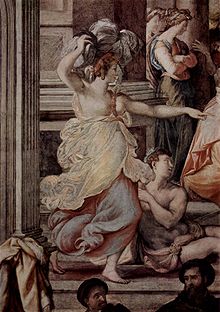San Giovanni Decollato
| Basic data | |
|---|---|
| Patronage : | St. John |
| Consecration day : | |
| Cardinal Deacon : | vacant |
| Address: | Via S. Giovanni Decollato 00186 Roma |
San Giovanni Decollato , also San Giovanni Battista Decollato ( Latin : Sancti Ioannis Baptistae Decollati ), is a church in Rome . It was created in the 16th century in the Mannerist style , was a brotherhood church of the Confraternità della Misericordia and is the title diaconia of the Roman Catholic Church . The building itself as well as the neighboring cloister and the adjoining oratory contain works of art of high standing. The only cardinal deacon so far was Mario Nasalli Rocca di Corneliano .
location
The church is in the XII. Roman Rione Ripa , about 250 meters northwest of the northern end of the Circus Maximus in almost the immediate vicinity of the Arch of Janus . Its name is derived from the martyrdom of John the Baptist , who was beheaded (ital. Decollato ).
Building history
Construction of the church and neighboring buildings began in 1535 and was completed by 1555. An older church called Santa Maria de fovea (also called Santa Maria della fossa or Santa Maria in petrocia ) was previously located on the building site . The client was the Confraternità della Misericordia ("Brotherhood of Mercy"), which was founded in 1488 by Florentines living in Rome . The furnishings were made accordingly by Florentine artists in the Tuscan style. Its most important member is likely to have been Michelangelo, who joined in 1514. The brotherhood had made it its business to accompany those sentenced to death on their last journey and, if necessary, to bury them after their execution. Once a year, both August 29th and June 24th, the Brotherhood had the right to give freedom to those condemned to death; this right continued into the 19th century. Restorations of the church took place in 1727 and for the last time in 1888.
Exterior
The facade of the church, which only remains in the raw brickwork, is kept very simple. The area is only structured by four pilasters with capitals in Doric order . Between the outer corner and inner pilasters, a niche is inserted in the upper surface on each side. Only the aedicula portal between the inner pilasters with the semicircular window inserted above gives a little decoration . The facade is crowned by a very simple triangular gable.
Church interior
The walls of the nave of the simple hall church with a wooden flat ceiling are pierced by three side chapels. The apse is square. The consistently uniform decoration of the interior is one of the “purest achievements of Mannerism of Tuscan origin in Rome”. The pilasters between the chapel arcades are decorated with fine stucco ornaments, and rich paintings cover the walls.
Altar painting and choir room

The first side chapel on the right contains the altarpiece The Birth of John the Baptist by Jacopo Zucchi , created in 1585. The altar in the middle chapel on the right contains the depiction of The Incredible Thomas by an artist from the school of Giorgio Vasari , painted around 1580. The last chapel on the right contains a Visitation of Mary created by Pomarancio around 1590 as an altarpiece.
On the triumphal arch , which separates the apse from the nave, there are frescoes by Giovanni Balducci , these depict six church fathers .
The first altar on the left contains the painting Madonna della Misericordia from the second half of the 15th century. The altarpiece in the middle chapel on the left was created by Battista Naldini around 1580, and its subject is John the Baptist .
The left side wall of the choir contains The Beheading of John by an unknown artist, possibly from Michelangelo's school . The resurrection is the theme on the right-hand side , it comes from Giovanni Balducci, known as Il Cosci .
Cloister
The adjacent cloister initially contains seven round marble lids in the floor. The executed people were buried here without a name, the most famous of whom, whose remains are here, is likely to be Giordano Bruno . The cloister itself was completed around 1559, it opens in round-arched column arcades.
Oratorio
The oratory, completed around 1530, again contains valuable frescoes . It is a cycle, depicting various stages in the life of John the Baptist, etc. a. by Jacopo del Conte , Francesco Salviati and other artists. One of the frescoes, The Annunciation of the Birth of John the Baptist, is said to contain a portrait of Michelangelo on the far left of the picture , this is not secured. Del Conte also created the altar painting, around 1550, depicting Johannes' entombment .
Access
The church and the other buildings are not open to the public. An interested visitor can ask the respective custodian for admission by ringing the bell in Via di San Giovanni Decollato , 22.
Individual evidence
- ^ Rosendorfer, Kirchenführer Rom , p. 95.
- ↑ a b Wundram, Reclams Art Guide, Italy. Volume V. Rome and Latium , p. 173.
- ^ Rosendorfer, Kirchenführer Rom , p. 96.
literature
- Anton Henze : Rome and Latium. Art monuments and museums (= Reclams Art Guide Italy. Vol. 5 = Reclams Universal Library . 8678). 4th, revised edition. Reclam, Stuttgart 1981, ISBN 3-15-008679-5 .
- Herbert Rosendorfer : Church leader Rome. 3rd, updated edition. Edition Leipzig, Leipzig 2005, ISBN 3-361-00485-3 .
Web links
- www.romeartlover.it , (English)
Coordinates: 41 ° 53 ′ 23.6 " N , 12 ° 28 ′ 54.6" E


